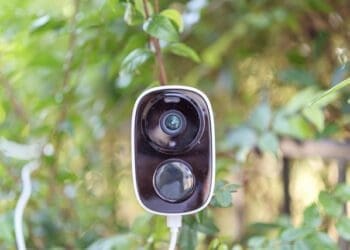In an era where security is paramount, keypads for door entry systems have emerged as a sophisticated solution to bolster door security and access control. These devices blend convenience with technology, offering a keyless way to manage entry into buildings.
With a range of options available, from digital keypads to those integrated with card readers, choosing the right keypad can significantly enhance the security of any property. Understanding the different types of keypad locks, their features, and how they contribute to an effective access control system is crucial for making an informed decision.
This article will explore the various types of keypads available, highlighting crucial features for enhanced security, such as deadbolt integration, access codes, and the ability to connect with broader entry systems. Reviews of popular keypads will offer insights into the top choices for both residential and commercial properties.
Additionally, guidance on choosing the right keypad for your property will ensure that readers are equipped to select a system that meets their specific needs for security, access, and ease of use. Whether updating existing door hardware or installing a new keypad entry system, this guide will navigate you through the essential considerations to ensure your property’s security is uncompromised.
Different Types of Keypad Systems

There are several types of keypad systems available for door entry, each with its own unique features and benefits. Understanding the differences between these systems can help you choose the best option for your property’s security needs.
Mechanical vs Digital Keypads
Keypads can be categorized as mechanical or digital (electronic). Mechanical keypads do not require batteries or power, making them a reliable option. They are smooth-working, easy to use, and allow for frequent code changes without any hassle. On the other hand, electronic keypads are battery-operated and often feature a backlit keypad for easy visibility in low-light conditions. They offer multiple customizable access codes that can be added or deleted as needed.
Standalone vs Networked Systems
Standalone access control systems are self-contained units that operate independently at each entry point. They are generally more affordable to install, making them suitable for smaller organizations or residential properties.
Each standalone system uses different control panels and security devices, enhancing overall security. However, managing multiple standalone systems can be labor-intensive, as users need to be added or removed manually from each access point.
Networked access control systems, on the other hand, are overseen by a centralized system, allowing administrators to manage access points from a single base. Users can be added or removed to multiple points simultaneously, making networked systems more efficient and less labor-intensive than standalone systems. Networked systems can be either on-premise, with an on-site server, or cloud-based, accessible remotely via the internet.
Proximity Card and Keypad Combos
Combining keypads with other access control devices, such as proximity card readers or intercoms, offers enhanced security and convenience. These combos often include a keypad integrated with a radio-frequency identification (RFID) proximity reader, allowing users to gain entry by either entering a code or presenting a proximity card or fob.
Some combos also incorporate intercoms, enabling communication with visitors before granting access. These combined systems provide an additional layer of security through two-factor authentication.
Crucial Features for Enhanced Security

When it comes to securing door entry systems, certain features are crucial for enhancing overall security. Here are some essential features to consider:
Encryption Standards
Encryption plays a vital role in protecting data transmitted between the keypad and the control system. Industry-standard encryption algorithms like AES (Advanced Encryption Standard) should be implemented to ensure secure communication.
Additionally, proper key management policies are necessary to prevent encryption keys from being lost or misused.
Compliance with encryption standards like FIPS 140-2 is also important. FIPS 140-2 provides stringent third-party assurance of security claims for products sold in the United States and Canada.
It covers products using cryptography for secure remote management, data encryption, digital signatures, and information protection.
If you want to learn more about this topic or other topics…. Click here
Audit Trails and Logging
Keypads with audit trail and logging capabilities can be invaluable for monitoring access attempts and identifying potential security breaches. These features record every time an employee accesses (or attempts to access) a secure location, along with a date and time stamp.
This information can help detect unusual activity and pinpoint the associated employee, if necessary.
Audit trails also provide insights into system usage patterns, allowing you to optimize access schedules and time zones based on employee entry patterns .
Access Scheduling
The ability to set up scheduling time frames is another crucial feature for enhanced security. Access control systems often allow administrators to create user codes for employees and establish specific time zones or schedules during which they can gain entry . This granular control over access permissions can significantly reduce the risk of unauthorized entry attempts.
Additionally, some systems offer the flexibility to create emergency or service codes for temporary access, which can be easily monitored and revoked through the audit trail logs.
Reviews of Popular Keypads

EMX KPX 100 Entry Keypad
The EMX KPX 100 is a reliable and durable entry keypad suitable for both residential and commercial applications. It features a backlit keypad for easy visibility and a weather-resistant construction, making it suitable for outdoor use . The keypad can store up to 1,000 user codes, allowing for flexible access control management.
Having fun with this context. I have other articles about this topic. Discover more!!!!!
Linear MDKP Exterior Wireless Keypad
The Linear MDKP is a wireless keypad designed for outdoor use. It has a sleek and modern design, and its wireless connectivity allows for easy installation without extensive wiring . The keypad can be programmed to control various access control systems, making it a versatile option for residential and commercial properties . It has a built-in radio transmitter with a 250-foot range in line-of-sight conditions, and access codes are programmed into the access controller or receiver .
Seco-Larm SK-1323-SDQ Keypad
The Seco-Larm SK-1323-SDQ is a compact and durable keypad designed for indoor and outdoor environments. It features a backlit keypad for easy visibility and weather-resistant construction for reliable performance in harsh conditions.
The keypad can be programmed to control various access control systems, making it a versatile option for a range of applications.
Some key features of the Seco-Larm SK-1323-SDQ include :
- 1.12~24 VAC/VDC operation
- 2.1,010 Users (Output #1: 1,000 users, Output #2: 10 users)
- 3.2 Form C relays, each rated 1 Amp @ 30VDC
- 4.Programmable output time from 1~99 seconds or toggle
- 5.Output #2 can be programmed for use with a doorbell
- 6.2 Egress inputs and 1 door sensor input
- 7.Backlit keys for easy nighttime use
- 8.Two multi-colored status LEDs
- 9.Able to mount to a single-gang back box
- 10.All features are programmed directly from the keypad
- 11.EEPROM memory protects programmed information in case of power loss
- 12.Optical tamper for added security
- 13.Circuitry is potted with epoxy for outdoor use
- 14.IP65 Weatherproof rating, rugged aluminum construction
Choosing the Right Keypad for Your Property

Choosing the right keypad for your property involves careful consideration of several factors to ensure optimal security, accessibility, and long-term value. Here are some crucial aspects to evaluate:
Assessing Property Layout and Access Points
Assessing your existing infrastructure involves considering your property’s physical layout and design. This includes identifying key access points, high-traffic areas, and any areas requiring special security considerations.
By mapping out your property’s layout and assessing potential vulnerabilities, you can strategically deploy keypad systems in locations that maximize security coverage and minimize potential risks.
Take advantage of new articles, click here.
Considering User Accessibility
Compatibility considerations extend beyond technical and physical aspects to encompass user experience and usability. The keypad interface’s ease of use and intuitiveness significantly ensure smooth operation and user adoption.
Customers should look for keypad systems with user-friendly interfaces and features like backlighting for nighttime use and audible feedback for successful entries.
By prioritizing user experience in their compatibility assessments, customers can ensure that the keypad systems they choose are technically compatible, user-friendly, and accessible to all authorized users.
Evaluating Long-term Costs
When evaluating keypad systems, it’s essential to consider both upfront and long-term costs. While keypads are generally an affordable access control solution, with costs ranging from $400 to $1,500 per device , the total cost can vary depending on factors such as the number of access points, existing infrastructure, and the complexity of the installation .
Additionally, compatibility considerations should also consider future scalability and expansion opportunities . As your security needs evolve and grow, your keypad system should be able to scale accordingly to accommodate additional access points, users, and functionalities.
Choosing a keypad system that offers scalability and flexibility ensures that your investment remains future-proof and can adapt to the changing needs of your security infrastructure over time.
By carefully assessing your property’s layout, considering user accessibility, and evaluating both upfront and long-term costs, you can make an informed decision and choose a keypad system that meets your specific security requirements while providing a seamless and convenient experience for all authorized users.
Conclusion
Through the exploration of various keypad systems, from the basic mechanical types to the more advanced networked and combination systems, this article has outlined the crucial factors and features to consider when selecting the best keypads for door entry systems.
It emphasized the importance of taking into account the security needs of a property, be it residential or commercial, along with the practicalities of installation, user accessibility, and long-term cost-effectiveness.
By highlighting the features essential for enhancing security, such as encryption standards, audit trails, and access scheduling, it has provided a comprehensive guide to navigating the complexities of choosing the right keypad entry system.
As the realm of security technology advances, the significance of making informed decisions when implementing keypad entry systems cannot be overstated. The selection process requires a detailed understanding of the property’s specific security requirements, the system’s scalability, and its ease of use for both administrators and users.
This guide aims to assist readers in not only identifying the best keypad systems for their unique needs but also underscores the broader implications of these choices on security, accessibility, and overall effectiveness.
By carefully considering the insights and recommendations presented, property owners and managers are well-equipped to enhance their security infrastructure with the most appropriate keypad entry systems, ensuring the safety and convenience of all who utilize them.
FAQs
What should I consider when choosing a keyless door lock?
When selecting a keyless door lock, it’s crucial to evaluate several factors to ensure security and convenience. Look for advanced security features that enhance safety and reliability. Ensure the lock is compatible with your door type and that it can be installed easily. Additionally, consider how user-friendly the lock is, as this will affect your daily interactions with it.
Which is superior, Kwikset or Schlage?
Schlage locks are generally more expensive than Kwikset, but they offer superior security features, durability, and robust construction, which justifies the higher cost.
While Kwikset provides good quality, especially in their deadbolts, Schlage’s locks, with their tight tolerances and strong deadbolt screws, are considered better in terms of overall quality and security.
What is the best keyless deadbolt on the market?
The Schlage Encode Smart WiFi Deadbolt is highly recommended due to its robust build, ease of installation, user-friendly controls, and excellent security features. For those looking for a deadbolt adapter lock, the Yale Approach Lock with Wi-Fi + Keypad is another top choice known for its reliability.
What type of lock offers the highest security for front doors?
For wooden doors, the five-lever mortice deadlock is considered highly secure. It operates with a key that engages five internal levers, effectively securing the door against drilling or picking attempts by intruders. This type of lock is renowned for its robustness and effectiveness in preventing unauthorized entry.





















































